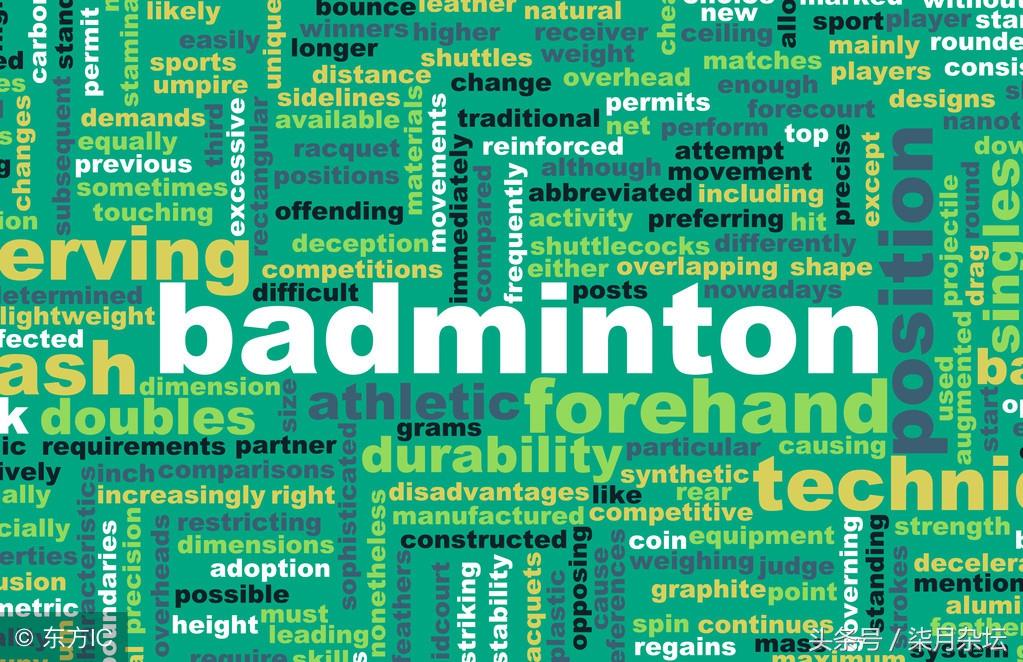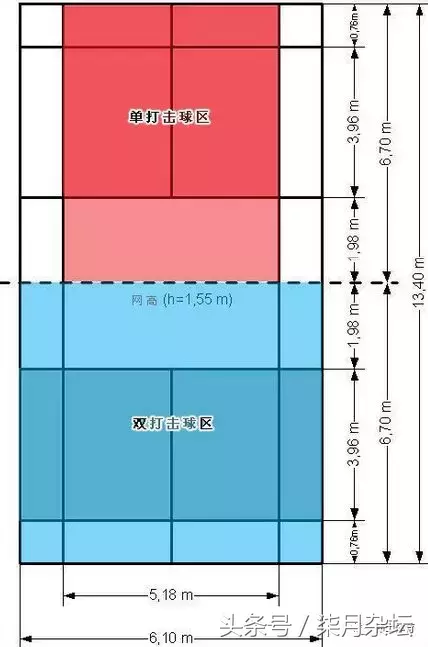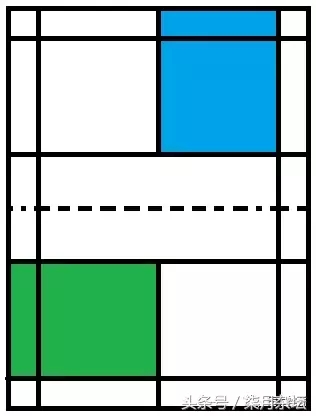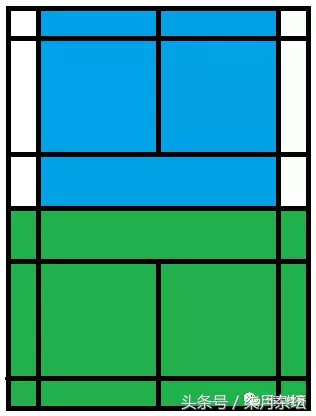
count scores
1. 21 points system, 2 wins in 3 games is better.
2. Score system for each ball
3. In each round, the winner will get 1 point.
When both sides score 20 points, the one who leads the other side by 2 points wins the game.
When both sides score 29 points, the one who gets 30 points first wins the game.
6. The winner of a game takes the lead in serving in the next game
Rules of rest and changing sides between matches
1. In a game, when the leading side reaches 11, both sides have a 60-second break.
Between two games, both sides have a 2-minute break.
In the deciding game, when the leading side reaches 11 points, the two sides exchange venues.
Badminton competition rules singles
1. At the beginning of a game (score 0: 0) or when the server scores an even number, the server serves in the right half. When the server scores an odd number, serve at the left half.
2. If the server scores a point, it will continue to serve in the next round.
3. If the receiver scores a point, it will become the server in the next round.
Badminton competition rules doubles
1. Like singles, when the server scores an even number, the server serves in the right half. When the server scores an odd number, serve at the left half.
2. If the server scores a point, it will continue to serve in the next round, and the server will remain the same.
3. If the receiver scores a point, it will become the server in the next round.
4. If and only if the server scores, the two players of the server exchange the left and right halves.
Diagram of badminton doubles competition rules
A badminton doubles match, A&B vs C&D, is described below. At the beginning of the match, A serves first and C receives the service.
| A description of the progress of the game | score | service area | Serve & receive | Winner | diagram |
|---|








Badminton competition rules: three strikes three.
Three against three, as the name implies, is three against three, so there are special rules and requirements in serving, standing and some playing methods.
The basic principles such as the position of serving and receiving should still follow the doubles rules of badminton. For example, when the score is even, the server stands in the right half and when the score is odd, the server stands in the left half.
1. Before the game, each team shall determine the first, second and third server and receiver, namely Team A (A1, A2 and A3) and Team B (B1, B2 and B3).
2. A1 serves, B1 receives.
3. B1 serves, A1 receives, and so on
4. After A1 serves and scores, A2 serves the next ball, that is, if Party A serves, A1, A2 and A3 serve in turn.
5. After B1 serves and scores, B2 serves the next ball, that is, if Party B serves, B1, B2 and B3 serve in turn.
Official ball
1. Sixteen feathers should be fixed on the ball support.
2. The length of each feather from the ball support surface to the feather tip is 62 ~ 70mm.
3. The top of the feather is round, with a diameter of 58 ~ 68 mm.
4. Feathers should be tied with thread or other suitable materials.
5. The bottom of the ball holder is spherical with a diameter of 25 ~ 28 mm.
6. The ball weighs 4.74 ~ 5.50g.
Badminton racket specifications
1. Badminton racket generally consists of racket head, racket shaft, racket handle and the joint between racket frame and racket shaft.
The length of a racket is no more than 68cm.
3. The length of racket handle and racket shaft shall not exceed 42 cm, the length of racket frame shall not exceed 25 cm, and the width shall be 20 cm.
4. The development direction of the racket: the weight is getting lighter and lighter, the racket frame is getting harder and harder, and the elasticity of the racket shaft is getting better and better.
Standard size of badminton court
1. The badminton court should be a rectangle, drawn with a line with a width of 40mm.
2. The color of the site line is preferably white, yellow or other easily recognizable colors.
3. All lines are part of the area it defines.
4. From the ground of the stadium, the net column is 1.55m high.
5. The net column must be firmly perpendicular to the ground, and keep the net tightly pulled.
6. The net post should be placed on the sideline of doubles.
7. Badminton nets should be made of dark high-quality strings, with evenly distributed squares with sides of 15 ~ 20mm.
8. Badminton net is 760mm wide up and down.
9. The rope or steel wire shall have sufficient length and strength, which can be firmly tightened and leveled with the top of the net column.
10. The net height in the center of the venue is 1.524 meters, and the net height at the sideline of doubles is 1.55 meters.
11. Both ends of the net must be fastened to the net column, and there should be no gap between them.
12. The length is 13.40m, the width of doubles is 6.10m, the width of singles is 5.18m, the diagonal length of doubles court is 14.723m, and the diagonal length of singles court is 14.366m..

Brief introduction of badminton team competition
Badminton team competitions include men’s and women’s teams, but team events are not Olympic events. The three famous badminton team competitions are Thomas Cup, Uber Cup and Sudirman Cup.
Thomas cup badminton.
Thomas Cup Badminton Competition is the highest level men’s badminton team competition in the world, that is, the World Men’s Badminton Team Championship, which was founded by the former International Badminton Federation in 1948. It is held every two years.
Uber cup badminton
The trophy of the World Women’s Badminton Team Championship (Uber Cup). Named after Mrs. Uber’s donation. Also known as the "World Women’s Badminton Team Championship". Uber Cup is the same as Thomas Cup. Before 1982, it was held every three years, and the competition adopted the best of seven games system. Since 1984, it has been held every two years, adopting the best of five games system.
Sudirman Cup
Also known as the World Badminton Mixed Team Championship, it adopts the best-of-five system and consists of five events: men’s singles, women’s singles, men’s doubles, women’s doubles and mixed doubles. It is the most important world competition representing the overall level of badminton, and is equally famous with Thomas Cup and Uber Cup. In 1989, the first Sudirman Cup was held in Indonesia. This competition is held every two years, with Thomas Cup and Uber Cup in even years and Sudirman Cup in odd years.
Badminton team competition rules
According to the rules of Sudirman Cup, there are men’s singles, women’s singles, men’s doubles, women’s doubles and mixed doubles. The order can be decided by both parties, but players can’t have both events, that is, they can’t participate in both events by themselves. Each event is the best of three games, with 21 points in each game. Best of five.
service fault
1. The ball is not served in the corresponding area.
2. The ball hangs on the net or stops at the top of the net.
3. The ball goes over the net and hangs on the net.
4. In doubles, the receiver’s partner receives or is touched by the ball.
Violate the rules during the game.
1. The ball falls outside the boundary of the field.
2. The ball passes under the mesh or net.
3. The ball didn’t cross the net.
4. The ball touches the ceiling or the surrounding walls
5. The ball touches the athlete’s body or clothes
6. The ball touches other objects or people outside the field.
7. When the ball is hit, it stays on the racket, and then it is dragged and thrown.
8. The ball was hit by the same player many times in one round.
9. The player’s racket, body or clothes touch the net or the support of the net.
10. Hit the ball through the net (when hitting the ball, the initial contact point between the racket and the ball is on the batter’s net side, except when the racket crosses the net with the ball).
Badminton service area
The effective area of singles serve is the blue area in the figure below.
The effective service area of doubles is the green area in the figure below.

Badminton half-court sideline
In singles, the effective range of the half-court sideline is the blue area in the picture below.
In doubles, the effective range of the half-court sideline is the green area in the figure below.

definition
1. Athletes: people who take part in badminton competitions.
2. A game: One or two athletes from each side is the most basic unit to decide the outcome.
3. Singles: A game played by one player from each side.
4. Doubles: A game played by two players from each side.
5. server: the party with the right to serve.
6. Receiver: the opponent who serves.
| Start of the game | 0 – 0 | Right half-court serve | A serves, C receives. | A & B |
| A&B scores a point, A&B will change sides, A will continue to serve in the left half, and C&D will keep their respective half unchanged. | 1 – 0 | Left half serve | A serves, D receives. | C & D |
| C&D scored one point, and A B C D kept their own half unchanged. | 1 – 1 | Left half serve | D serves, A receives. | A & B |
| A&B scored a point and served at the right half. A, B, C and D kept their respective half unchanged. | 2 – 1 | Right half-court serve | B serves, C receives. | C & D |
| C&D scores a point and serves at the right half. A B C D keeps their own half unchanged. | 2 – 2 | Right half-court serve | C serves, B receives. | C & D |
| C&D scores a point, C&D will change sides, C will continue to serve in the left half, and A&B will keep their respective half unchanged. | 2 – 3 | Left half serve | C serves, A receives. | A & B |
| A&B scored a point and served at the left half. A, B, C and D kept their respective half unchanged. | 3 – 3 | Left half serve | A serves, C receives. | A & B |
| A&B scores a point, A&B will change sides, A will continue to serve in the right half, and C&D will keep their respective half unchanged. | 4 – 3 | Right half-court serve | A serves, D receives. | C & D |